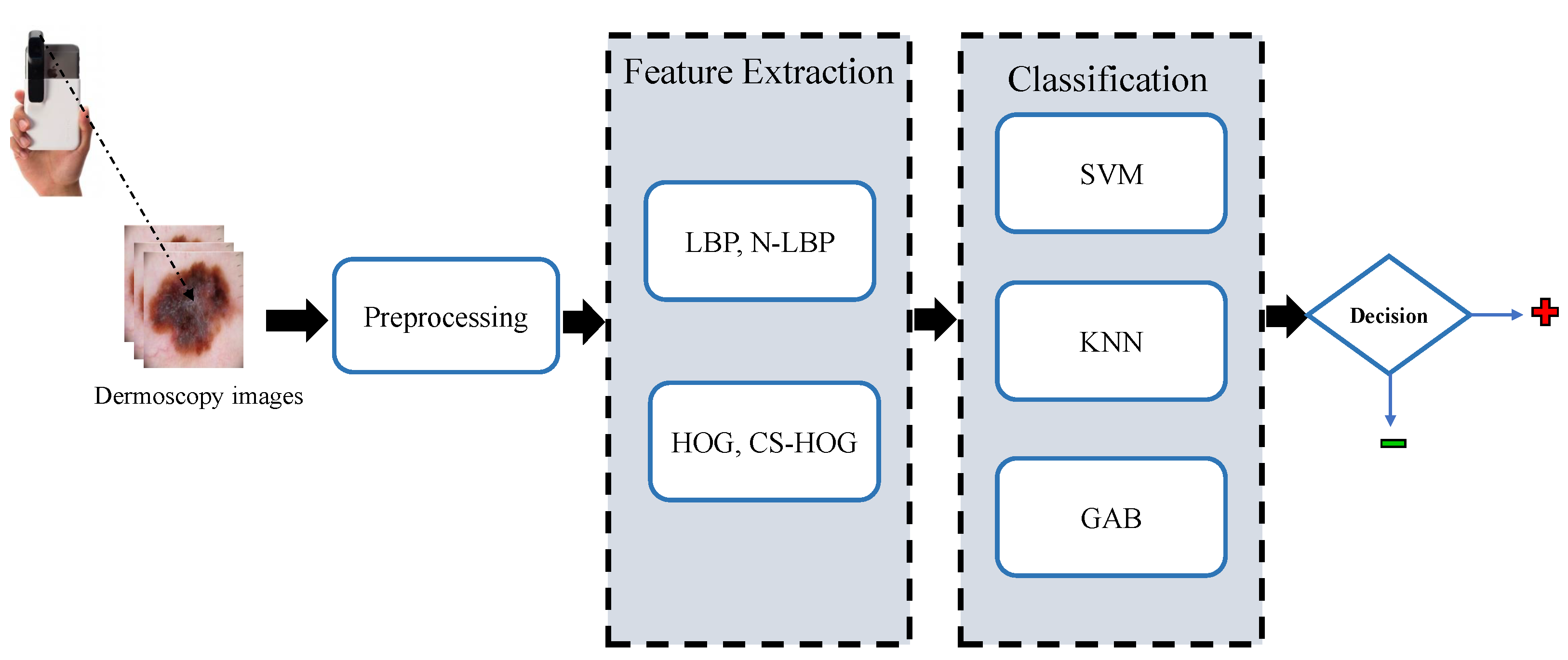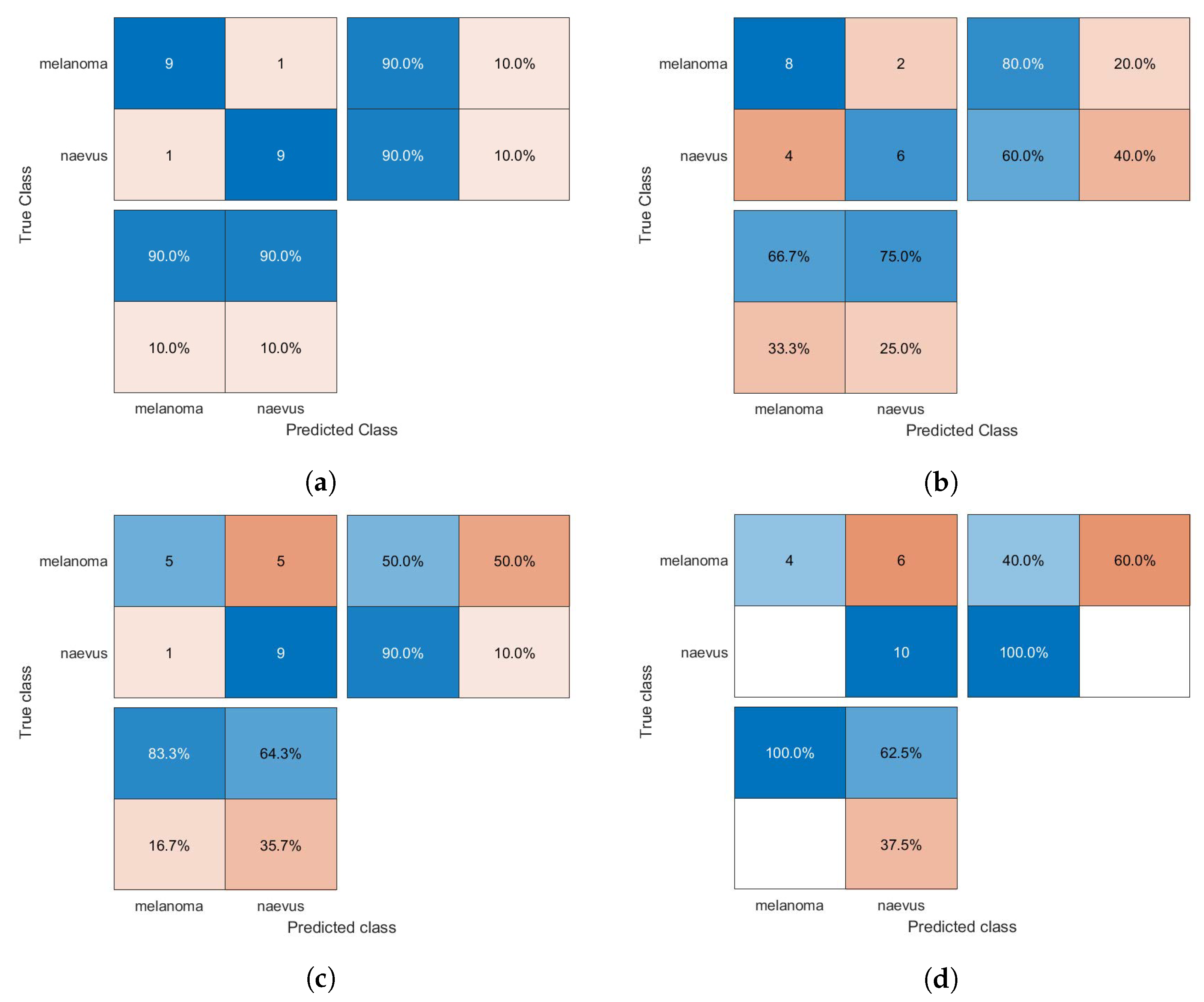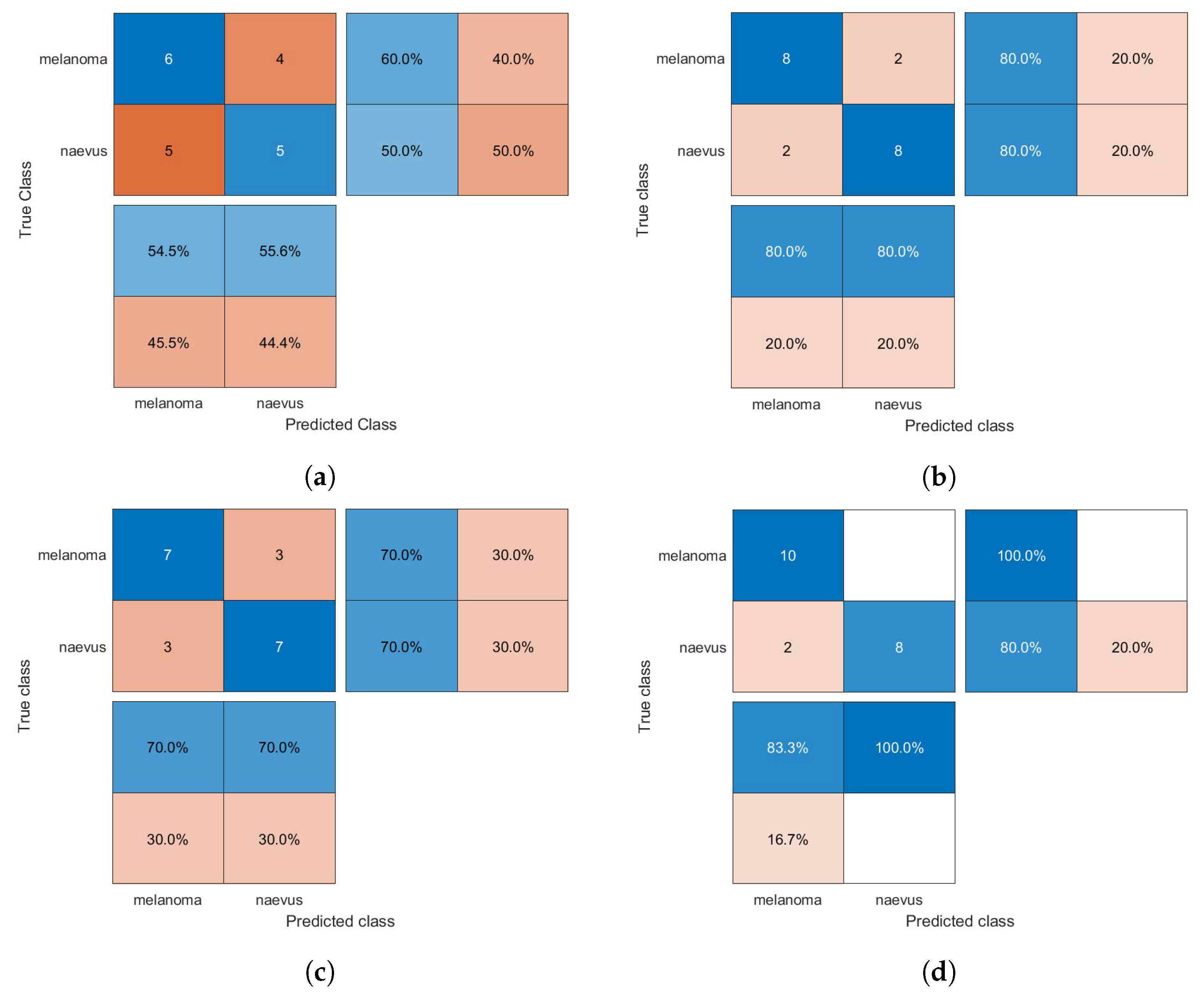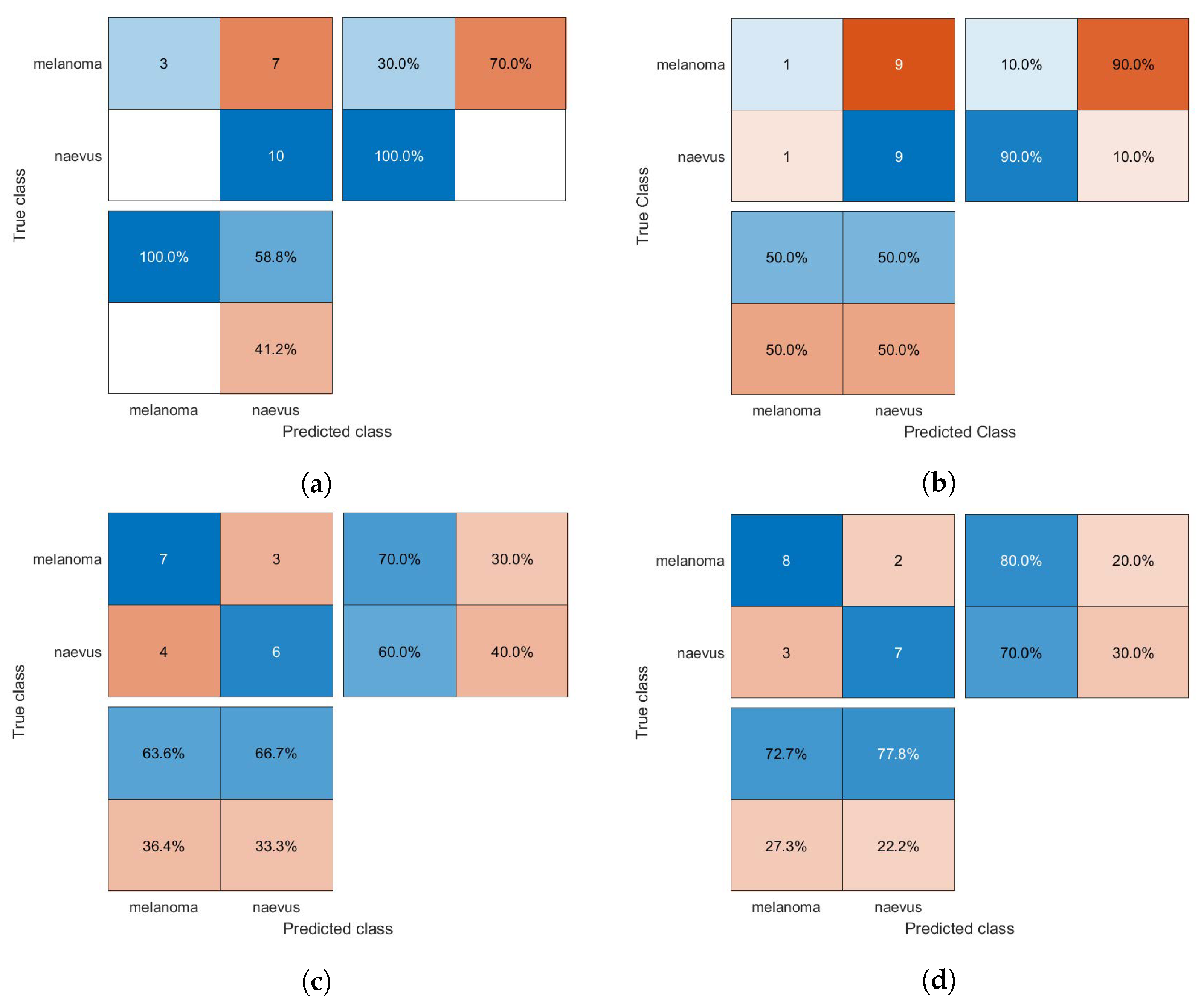A Multi-Feature Fusion Framework for Automatic Skin Cancer Diagnostics
Abstract
1. Introduction
2. Related Work
3. Proposed Methodology
3.1. Image Preprocessing
Lesion Segmentation
3.2. Feature Extraction
3.2.1. Local Binary Patterns (LBP)
3.2.2. Histogram of Oriented Gradients (HOG)
3.3. Feature Classification
3.3.1. Support Vector Machines (SVMs)
3.3.2. k-Nearest Neighbors (kNN)
| Algorithm 1 Main steps in the kNN algorithm |
| Input: Training samples G, test sample g, K Output: Class label of test sample 1: Measure the distance between g and each sample in G 2: Select K samples in G which are nearest to g; indicate the set by P (∈G) 3: Assign g the class that is the majority class |
3.3.3. Gentle AdaBoost (GAB)
| Algorithm 2 The GentleAdaBoost algorithm |
| Input: Training data ; i[1, N] with corresponding class labels ; i[1, N] Output: A robust classifier 1: Initialize weights = 1/N, and = 0 2: For m = 1, 2, 3,…, M do 3: Train by weighted least square of to with weights 4: Update = + 5: Update the weights by and normalize the weights = 1 6: end for 7: Final Classifier = sign [] |
4. Experimental Results and Analysis
- –
- True Positive (TP) denotes the positive cases that are correctly predicted as positive.
- –
- True Negative (TN) denotes the negative cases that are correctly predicted as negative.
- –
- False Positive (FP) denotes the positive cases that are incorrectly predicted as negative.
- –
- False Negative (FN) denotes the negative cases that are incorrectly predicted as positive.
5. Conclusions
Author Contributions
Funding
Institutional Review Board Statement
Informed Consent Statement
Data Availability Statement
Conflicts of Interest
References
- Sung, H.; Ferlay, J.; Siegel, R.L.; Laversanne, M.; Soerjomataram, I.; Jemal, A.; Bray, F. Global cancer statistics 2020: GLOBOCAN estimates of incidence and mortality worldwide for 36 cancers in 185 countries. CA Cancer J. Clin. 2021, 71, 209–249. [Google Scholar] [CrossRef] [PubMed]
- Korotkov, K.; Garcia, R. Computerized analysis of pigmented skin lesions: A review. Artif. Intell. Med. 2012, 56, 69–90. [Google Scholar] [CrossRef]
- Bakheet, S.; Al-Hamadi, A. Computer-Aided Diagnosis of Malignant Melanoma Using Gabor-Based Entropic Features and Multilevel Neural Networks. Diagnostics 2020, 10, 822. [Google Scholar] [CrossRef] [PubMed]
- Singh, L.; Janghel, R.R.; Sahu, S.P. SLICACO: An automated novel hybrid approach for dermatoscopic melanocytic skin lesion segmentation. Int. J. Imaging Syst. Technol. 2021, 31, 1817–1833. [Google Scholar] [CrossRef]
- Bakheet, S.; El-Nagar, A. A Deep Neural Approach for Real-Time Malignant Melanoma Detection. Appl. Math. Inf. Sci. 2021, 15, 89–96. [Google Scholar]
- Blum, A.; Hofmann-Wellenhof, R.; Luedtke, H.; Ellwanger, U.; Steins, A.; Roehm, S.; Garbe, C.; Soyer, H. Value of the clinical history for different users of dermoscopy compared with results of digital image analysis. J. Eur. Acad. Dermatol. Venereol. 2004, 18, 665–669. [Google Scholar] [CrossRef]
- Ma, Z.; Tavares, J.M.R. A review of the quantification and classification of pigmented skin lesions: From dedicated to hand-held devices. J. Med. Syst. 2015, 39, 177. [Google Scholar]
- Barata, C.; Celebi, M.E.; Marques, J.S. Melanoma detection algorithm based on feature fusion. In Proceedings of the 2015 37th Annual International Conference of the IEEE Engineering in Medicine and Biology Society (EMBC), Milan, Italy, 25–29 August 2015; IEEE: Piscataway, NJ, USA, 2015; pp. 2653–2656. [Google Scholar]
- Giotis, I.; Molders, N.; Land, S.; Biehl, M.; Jonkman, M.F.; Petkov, N. MED-NODE: A computer-assisted melanoma diagnosis system using non-dermoscopic images. Expert Syst. Appl. 2015, 42, 6578–6585. [Google Scholar] [CrossRef]
- Hugo, W.; Zaretsky, J.M.; Sun, L.; Song, C.; Moreno, B.H.; Hu-Lieskovan, S.; Berent-Maoz, B.; Pang, J.; Chmielowski, B.; Cherry, G.; et al. Genomic and transcriptomic features of response to anti-PD-1 therapy in metastatic melanoma. Cell 2016, 165, 35–44. [Google Scholar] [CrossRef]
- Barata, C.; Celebi, M.E.; Marques, J.S. Improving dermoscopy image classification using color constancy. IEEE J. Biomed. Health Inform. 2014, 19, 1146–1152. [Google Scholar]
- Ross-Howe, S.; Tizhoosh, H.R. The effects of image pre-and post-processing, wavelet decomposition, and local binary patterns on U-nets for skin lesion segmentation. In Proceedings of the 2018 International Joint Conference on Neural Networks (IJCNN), Rio de Janeiro, Brazil, 8–13 July 2018; IEEE: Piscataway, NJ, USA, 2018; pp. 1–8. [Google Scholar]
- Chakraborty, S.; Mali, K.; Banerjee, S.; Roy, K.; Saha, D.; Chatterjee, S.; Dutta, S.; Majumder, S. Bag-of-features based classification of dermoscopic images. In Proceedings of the 2017 4th International Conference on Opto-Electronics and Applied Optics (Optronix), Kolkata, India, 2–3 November 2017; IEEE: Piscataway, NJ, USA, 2017; pp. 1–6. [Google Scholar]
- Silveira, M.; Nascimento, J.C.; Marques, J.S.; Marçal, A.R.; Mendonça, T.; Yamauchi, S.; Maeda, J.; Rozeira, J. Comparison of segmentation methods for melanoma diagnosis in dermoscopy images. IEEE J. Sel. Top. Signal Process. 2009, 3, 35–45. [Google Scholar] [CrossRef]
- Bakheet, S. An SVM framework for malignant melanoma detection based on optimized HOG features. Computation 2017, 5, 4. [Google Scholar] [CrossRef]
- Firmansyah, H.R.; Kusumaningtyas, E.M.; Hardiansyah, F.F. Detection melanoma cancer using ABCD rule based on mobile device. In Proceedings of the 2017 International Electronics Symposium on Knowledge Creation and Intelligent Computing (IES-KCIC), Surabaya, Indonesia, 26–27 September 2017; IEEE: Piscataway, NJ, USA, 2017; pp. 127–131. [Google Scholar]
- Nasir, M.; Attique Khan, M.; Sharif, M.; Lali, I.U.; Saba, T.; Iqbal, T. An improved strategy for skin lesion detection and classification using uniform segmentation and feature selection based approach. Microsc. Res. Tech. 2018, 81, 528–543. [Google Scholar] [CrossRef] [PubMed]
- Bhimavarapu, U.; Battineni, G. Skin Lesion Analysis for Melanoma Detection Using the Novel Deep Learning Model Fuzzy GC-SCNN. Healthcare 2022, 10, 962. [Google Scholar] [CrossRef] [PubMed]
- Bakheer, S.; Al-Hamadi, A. A deep neural framework for real-time vehicular accident detection based on motion temporal templates. Heliyon 2022, 8, 397–404. [Google Scholar]
- Victor, A.; Ghalib, M. Automatic detection and classification of skin cancer. Int. J. Intell. Eng. Syst. 2017, 10, 444–451. [Google Scholar] [CrossRef]
- Dubal, P.; Bhatt, S.; Joglekar, C.; Patil, S. Skin cancer detection and classification. In Proceedings of the 2017 6th international conference on electrical engineering and informatics (ICEEI), Langkawi, Malaysia, 25–27 November 2017; IEEE: Piscataway, NJ, USA, 2017; pp. 1–6. [Google Scholar]
- Otsu, N. A Threshold Selection Method from Gray-Level Histograms. IEEE Trans. Syst. Man, Cybern. 1979, 9, 62–66. [Google Scholar] [CrossRef]
- Vincent, L. Morphological Area Openings and Closings for Grey-scale Images. In Proceedings of the Shape in Picture; Springer: Berlin/Heidelberg, Germany, 1994; pp. 197–208. [Google Scholar]
- Mahalle, A.G.; Shah, A.M. An Efficient Design for Canny Edge Detection Algorithm Using Xilinx System Generator. In Proceedings of the 2018 International Conference on Research in Intelligent and Computing in Engineering (RICE), San Salvador, El Salvador, 22–24 August 2018; pp. 1–4. [Google Scholar] [CrossRef]
- Ahonen, T.; Hadid, A.; Pietikainen, M. Face description with local binary patterns: Application to face recognition. IEEE Trans. Pattern Anal. Mach. Intell. 2006, 28, 2037–2041. [Google Scholar] [CrossRef]
- Tizhoosh, H.R. Barcode annotations for medical image retrieval: A preliminary investigation. In Proceedings of the 2015 IEEE International Conference on Image Processing (ICIP), Quebec City, QC, Canada, 27–30 September 2015; IEEE: Piscataway, NJ, USA, 2015; pp. 818–822. [Google Scholar]
- Ojala, T.; Pietikainen, M.; Maenpaa, T. Multiresolution gray-scale and rotation invariant texture classification with local binary patterns. IEEE Trans. Pattern Anal. Mach. Intell. 2002, 24, 971–987. [Google Scholar] [CrossRef]
- Dalal, N.; Triggs, B. Histograms of oriented gradients for human detection. In Proceedings of the 2005 IEEE Computer Society Conference on Computer Vision and Pattern Recognition (CVPR’05), San Diego, CA, USA, 20–25 June 2005; IEEE: Piscataway, NJ, USA, 2005; Volume 1, pp. 886–893. [Google Scholar]
- Azad, R.; Azad, B.; Kazerooni, I.T. Optimized method for iranian road signs detection and recognition system. arXiv 2014, arXiv:1407.5324. [Google Scholar] [CrossRef]
- Linsangan, N.B.; Adtoon, J.J. Skin cancer detection and classification for moles using k-nearest neighbor algorithm. In Proceedings of the 2018 5th International Conference on Bioinformatics Research and Applications, Hong Kong, 27–29 December 2018; pp. 47–51. [Google Scholar]
- Murugan, A.; Nair, S.A.H.; Kumar, K. Detection of skin cancer using SVM, random forest and kNN classifiers. J. Med. Syst. 2019, 43, 269. [Google Scholar] [CrossRef] [PubMed]
- Freund, Y. An adaptive version of the boost by majority algorithm. Mach. Learn. 2001, 43, 293–318. [Google Scholar] [CrossRef]
- Friedman, J.; Hastie, T.; Tibshirani, R. The Elements of Statistical Learning; Springer Series in Statistics New York; Springer: New York, NY, USA, 2001; Volume 1. [Google Scholar]
- Friedman, J.; Hastie, T.; Tibshirani, R. Additive logistic regression: A statistical view of boosting (with discussion and a rejoinder by the authors). Ann. Stat. 2000, 28, 337–407. [Google Scholar] [CrossRef]
- Vezhnevets, A.; Vezhnevets, V. Modest AdaBoost-teaching AdaBoost to generalize better. In Proceedings of the Graphicon, Novosibirsk Akademgorodok, Russia, 20–24 June 2005; pp. 322–325. [Google Scholar]
- Santos, M.S.; Soares, J.P.; Abreu, P.H.; Araujo, H.; Santos, J. Cross-validation for imbalanced datasets: Avoiding overoptimistic and overfitting approaches [research frontier]. IEEE Comput. INtelligeNCe MagaziNe 2018, 13, 59–76. [Google Scholar] [CrossRef]
- Jeyakumar, J.P.; Jude, A.; Henry, A.G.P.; Hemanth, J.D. Comparative Analysis of Melanoma Classification Using Deep Learning Techniques on Dermoscopy Images. Electronics 2022, 11, 2918. [Google Scholar] [CrossRef]
- Mukherjee, S.; Adhikari, A.; Roy, M. Malignant melanoma detection using multi layer preceptron with visually imperceptible features and PCA components from MED-NODE dataset. Int. J. Med. Eng. Inform. 2020, 12, 151–168. [Google Scholar] [CrossRef]
- Mukherjee, S.; Adhikari, A.; Roy, M. Malignant melanoma detection using multi layer perceptron with optimized network parameter selection by pso. In Contemporary Advances in Innovative and Applicable Information Technology; Springer: Berlin/Heidelberg, Germany, 2019; pp. 101–109. [Google Scholar]







| Models | AC (%) | SE (%) | SP (%) | PPV (%) | NPV (%) |
|---|---|---|---|---|---|
| HOG + SVM | 80 | 80 | 80 | 80 | 80 |
| CS-HOG + SVM | 85 | 100 | 70 | 76.9 | 100 |
| LBP + SVM | 70 | 50 | 90 | 83.3 | 64.3 |
| N-LBP + SVM | 70 | 40 | 100 | 100 | 62.5 |
| HOG + GAB | 90 | 90 | 90 | 90 | 90 |
| CS-HOG + GAB | 80 | 80 | 80 | 80 | 80 |
| LBP + GAB | 70 | 70 | 70 | 70 | 70 |
| N-LBP + GAB | 94 | 100 | 92 | 83.3 | 80 |
| HOG + kNN | 65 | 30 | 100 | 100 | 58.8 |
| CS-HOG + kNN | 55 | 10 | 100 | 100 | 52.6 |
| LBP + kNN | 65 | 70 | 60 | 63.6 | 66.7 |
| N-LBP + kNN | 75 | 80 | 70 | 72.7 | 77.8 |
| Method | AC (%) | SE (%) | SP (%) |
|---|---|---|---|
| Our method | 94.0 | 100 | 92.0 |
| Jeyakumar et al. [37] | 97.1 | 96.8 | 96.0 |
| Singh et al. [4] | 81.8 | 70.0 | 82.6 |
| Mukherjee et al. [38] | 87.2 | 87.4 | 86.8 |
| Mukherjee et al. [39] | 85.9 | 86.2 | 85.5 |
| Giotis et al. [9] | 81.0 | 80.0 | 81.0 |
Disclaimer/Publisher’s Note: The statements, opinions and data contained in all publications are solely those of the individual author(s) and contributor(s) and not of MDPI and/or the editor(s). MDPI and/or the editor(s) disclaim responsibility for any injury to people or property resulting from any ideas, methods, instructions or products referred to in the content. |
© 2023 by the authors. Licensee MDPI, Basel, Switzerland. This article is an open access article distributed under the terms and conditions of the Creative Commons Attribution (CC BY) license (https://creativecommons.org/licenses/by/4.0/).
Share and Cite
Bakheet, S.; Alsubai, S.; El-Nagar, A.; Alqahtani, A. A Multi-Feature Fusion Framework for Automatic Skin Cancer Diagnostics. Diagnostics 2023, 13, 1474. https://doi.org/10.3390/diagnostics13081474
Bakheet S, Alsubai S, El-Nagar A, Alqahtani A. A Multi-Feature Fusion Framework for Automatic Skin Cancer Diagnostics. Diagnostics. 2023; 13(8):1474. https://doi.org/10.3390/diagnostics13081474
Chicago/Turabian StyleBakheet, Samy, Shtwai Alsubai, Aml El-Nagar, and Abdullah Alqahtani. 2023. "A Multi-Feature Fusion Framework for Automatic Skin Cancer Diagnostics" Diagnostics 13, no. 8: 1474. https://doi.org/10.3390/diagnostics13081474
APA StyleBakheet, S., Alsubai, S., El-Nagar, A., & Alqahtani, A. (2023). A Multi-Feature Fusion Framework for Automatic Skin Cancer Diagnostics. Diagnostics, 13(8), 1474. https://doi.org/10.3390/diagnostics13081474






